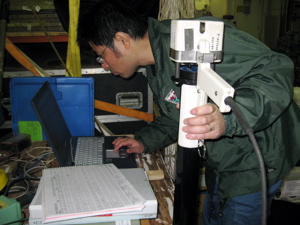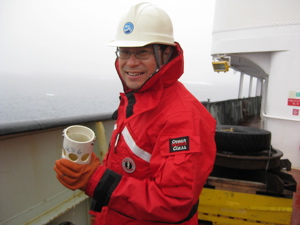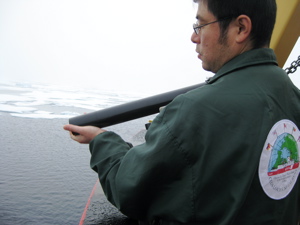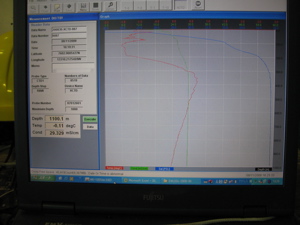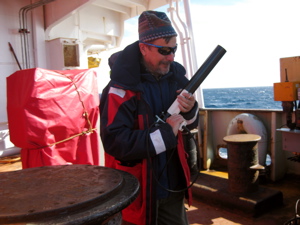Gerty WardAugust 11, 2008Because the parameters of conductivity, temperature and depth are so important in oceanographic study, scientists are constantly testing ways to measure it more frequently and more accurately. One interesting technique uses the X-CTD. This is a small CTD sensing device that is *shot* from the ship into the water. As the sensor sinks into the water, it sends its readings back up a very thin line to a computer on board.
The X-CTD project on board is run by Shigeto Nishino of JAMSTEC in Japan. The goal of his project is to map the distribution of different water masses throughout the Canada Basin in order to understand the general ocean circulation here. He is especially interested in the nutrient-rich water that moves along the continental shelf because this water is essential for biological activity. More information about his project can be found here: http://www.jamstec.go.jp/arctic/ X-CTDs have the advantage of being quick so they can be done quite frequently and while the ship is moving. For example, as the ship steams over area of steep topography, where the bottom drops off very quickly as it does at the edge of the continental shelf, X-CTDs can be deployed almost continuously, allowing measurements to be taken as often as every 15 minutes. Once the computer is told what is going on, the X-CTD can be "shot" off the stern. In about 2 minutes, the sensor sinks to 1100 meters, taking measurements all along the way.
This profile looks quite similar to the one obtained from water sampling with the Rosette. The red line is temperature and the blue is salinity. Notice that the temperature maximum is reached just above 400 meters depth (depth is on the right). These data are similar to the Rosette data and help complete the "ocean water sandwich". Waldeck Walczowski is helping Shigeto collect his X-CTD data. He is the deputy! We are well-covered, both with CTD data and sheriff protection. Last updated: October 7, 2019 | |||||||||||||||||||||||||||
Copyright ©2007 Woods Hole Oceanographic Institution, All Rights Reserved, Privacy Policy. | |||||||||||||||||||||||||||


